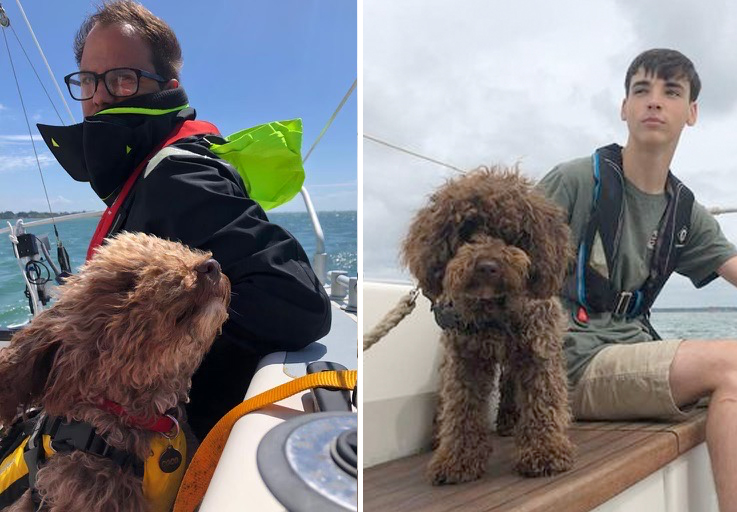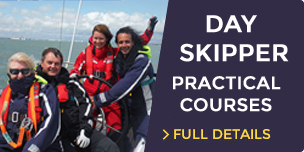Taking your Dog Sailing
1,206 views | March 31st, 2022Dog Life Jackets
You must make sure your dog has a lifejacket. A life jacket will keep them safe and help them conserve energy if they do go in the water, helps with visibility if they go over and tend to have a handle that make lifting smaller dogs very convenient and is useful for lifting or hooking them out of the water. Another benefit to a doggy life jacket is that it helps keep them dry and cosy. Prices for dog buoyancy aids range from just up over £20 to about £100
Down to Business
Let’s start with toilet training – because teaching your dog where to go on board is the biggest issue. To be honest, on day trips, through all our dogs, this has never been an issue. If this is your dog’s first excursion, probably best to keep it short. But when you’re going on longer trips or if your dog needs to relieve itself you should supply a safe space to go to the toilet. Puppy training pads are convenient. An astroturf or carpet square work and are reusable. Did you know can get puppy pads with a grass fragrance to encourage the dogs to go? If you can get a carpet square that has a dog ‘scent’ this will encourage your dog to go. Once the square has been used and has your dog’s scent, this should establish and set the pattern. The issue with a carpet or astroturf, especially if you are planning a longer trip will be the smell. If you attach the carpet to a rope and wash it over the side every day your dog’s super-sensitive nose will still pick up the scent and use the carpet. Whatever you decide to use, positioning Fido’s ‘bathroom spot’ place should try to keep the same spot. The bow tends to be the most convenient out of the way place.
Dog Friendly
If it’s not your boat, check with the skipper or charter company about their policy on dogs and how they might like you to deal with these things. Most marinas are dog friendly, but it’s always a good idea to check ahead that dogs are welcome, and can fit into your plans on land. Small dogs are more readily accepted into bars and restaurants – but never assume everywhere is doggy friendly. Smaller dogs are generally easier to take into places, but it won’t be much fun for your pooch if they can’t get off the boat.
Your Dog
Our dog, Coco (some kind of oodle) is quite small, she can tuck under an arm for climbing into dinghies, sit on a paddleboard, doesn’t need long walks. Previously we had medium size dogs (Wheaten Terriers) which were still fairly easy – though a two person job getting into an inflatable from the deck. It’s important to consider if your dog will need to go below deck, or onto an inflatable the practicalities of them physically getting up and down. All our dogs have been happy on deck, though Coco is a little unnerved by the movement on pontoons. Like people there are no one size fits all rule, and it’s probably wise to introduce Fido or Fifi to life onboard slowly if they struggle with new situations. Basic dog training commands like ‘sit’ ‘wait’ and ‘come’ will mean that your dog doesn’t get under your feet. Having said that, remember dogs like small children need do constant supervision. Dogs should be tethered when sailing. https://www.ezydog.co.uk/marine-leash
Hydration
Keep them hydrated. Remember a water bowl. If you can’t cool the boat, or provide shade, cool the dog instead. Cooling pads are great for making sure they don’t get too hot under the collar
You could take them up on deck and give them a good spray down, or if safe let them go for a swim until they’re cooled off.
Longer Trips
If you are planning on taking Rover often or for an extended period a dog first aid kit is good to have on board. You might need to think about a padded crate that you can put you dog in to keep safe during rough weather. You might want to consider netting fixed to your lifelines. If you are travelling to different countries you will need to check their regulations. Sailing to the EU dog owners need to register for an animal health certificate (AHC). These are issued by a vet, last for 4 months and need to be issued 10 days before your planned travel.
Now it might seem like I’m trying to put you off, let me tell you how much I enjoy sailing with our dog. How much all our dogs have enjoyed sailing with us. But all these things are important and there’s much more to taking your dog than making sure you’ve got plenty of dog food. With a bit of planning, your dog can become a salty dog and a great sailing companion.
Posted by: First Class Sailing









